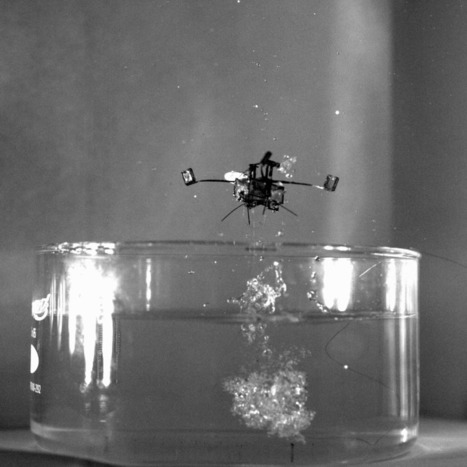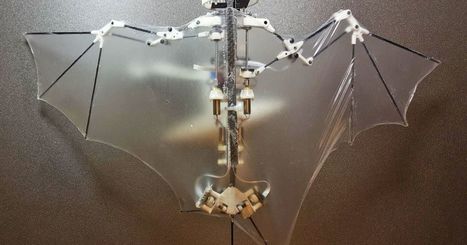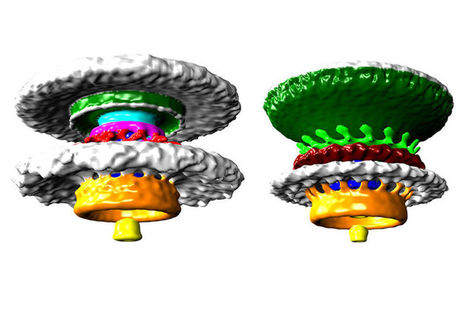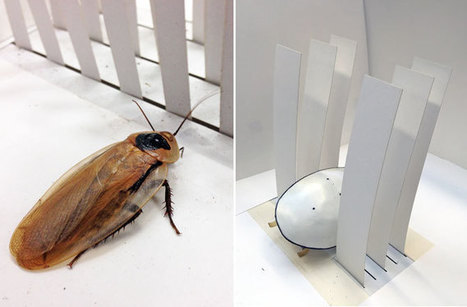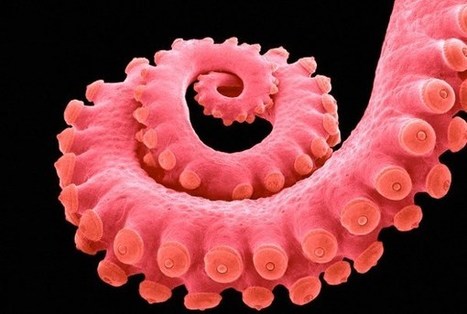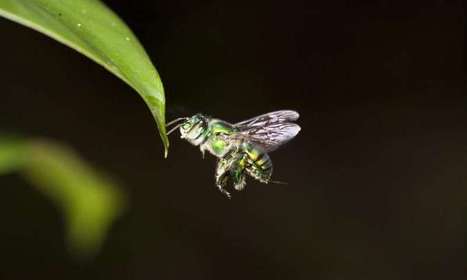 Your new post is loading...
 Your new post is loading...
"What’s better than a robot inspired by bees? A robot inspired by bees that can swim.Researchers led by a team at Harvard University have developed a tiny, 175-milligram (about two feathers) device with insect-inspired wings that can both flap and rotate, allowing it to either fly above the ground or swim in shallow waters and easily transition between the two."
"Using a mathematical model and the mackerel pectoral fin as an illustrative example, [...] researchers show how fin stiffness may be changed by applying a u-shaped curvature at the fin's base. The effect, the researchers say, might underlie the ability of fish to swim at widely varying speeds in all kinds of currents with great maneuverability. [...] The researchers say their model suggests intriguing possibilities for the design of robotic swimmers."
"Robotic birds and winged insects are relatively easy to create, but with over 40 joints in their wings, bats offer a new level of intricacy. Or, as Caltech professor and Jet Propulsion Laboratory researcher Soon-Jo Chung put it during a press conference, "bat flight is the holy grail of aerial robotics. [...] By simplifying that wing structure into just nine key joints covered by a flexible membrane, however, the team successfully created the first Bat Bot. Built from carbon fiber bones and 3D-printed socket joints, Bat Bot weighs just 93 grams and the silicon-based wing membrane is only 56 microns thick with a roughly one-foot wingspan."
Kevin Kit Parker wants to build a human heart. His young daughter loves the New England Aquarium in Boston. In this Science report, father’s and daughter’s obsessions have combined in an unlikely creation: a nickel-sized artificial stingray whose swimming is guided by light and powered by rat heart muscle cells.
Bees control their flight using the speed of motion (optic flow) of the visual world around them. A study by Scientists at the University of Sheffield Department of Computer Science suggests how motion-direction detecting circuits could be wired together to also detect motion-speed, which is crucial for controlling bees’ flight.
“Honeybees are excellent navigators and explorers, using vision extensively in these tasks, despite having a brain of only one million neurons,” said Alex Cope, PhD., lead researcher on the paper. “Understanding how bees avoid walls, and what information they can use to navigate, moves us closer to the development of efficient algorithms for navigation and routing, which would greatly enhance the performance of autonomous flying robotics,” he added.
An advance in understanding why the seahorse’s tail is made of square plates could inform the next generation of robotics and armor. In an engineering study that looked at the mechanics of how the fish’s tail works, researchers found the structure’s shape is optimized to resist crushing and to grasp while bending and twisting.
"Among bacteria’s many attributes, perhaps one of its most overlooked yet important ones is its ability to propel itself via flagellum, a unique appendage hanging off its end. This mechanism is a perfect example of a naturally occurring, biological wheel. Aside from the beautiful novelty of these images, researchers could study them to develop better motors for nano-robots, or to design better antibiotics that target the flagellum specific to a certain bacteria.[...] Now, for the first time, scientists were able to take a high resolution, 3D look at these wheels at work, using an electron microscope."
A new developed approach to 3D printing has produced an octopus-inspired robotic device claimed to offer an unprecedented level of agility. Engineers crafted the artificial muscle using commercially available material and say it points to a future of advanced robotic devices inspired by nature.
"Scientists have developed a tiny robot - based on the water strider insect - that can jump on water. The robotic version uses the same forces to jump as the water strider - pushing off without breaking the surface. It takes off with a downward force that never exceeds the surface tension of water - the force that "glues" surface water molecules together."
"While researchers hope this robot won’t be crawling around your kitchen floor, they do think a new cockroach-inspired bot will be able to slip through tiny cracks to find people buried in the rubble of collapsed buildings. Dubbed “veloci-roach,” the crawling device uses sensors and locomotion like many other bio-inspired devices. But this one flips on its side to shimmy through spaces that would normally prove too small..."
"NASA has chosen its next batch of proposals under its advanced concepts program, including the use of soft-robotic rovers for exploring gas-giant moons, and autonomous robots capable of crawling, hopping, and rolling around the surface of the Moon. [...] One of the more interesting proposals calls for a soft robotic squid/eel hybrid. The device would be equipped with a short antenna on its back to draw power from changing magnetic fields. The aquatic rover could be used to explore the subsurface oceans on Europa and Enceladus."
"Surgeries might be easier and safer due to a new invention by researchers from the Sant'Anna School of Advanced Studies in Italy, a robotic arm that was inspired by tentacles of an octopus. The robotic arm device moves by using its inflatable chambers, imitating the natural motion of an octopus twisting and elongating its tentacles in any direction it desires."
"Almost anything that flies, be it a plane, a spacecraft, or a drone, has an inertial navigation system with accelerometers and gyroscopes that control yaw, pitch and roll, and thus the flight path. Flying insects like bees, however, don't have inertial systems to guide them; they rely exclusively on what they see. This has inspired two researchers at the Aix-Marseille University in France to build a drone that imitates the way these insects navigate. Their mission was to design it to fly and circumvent obstacles by relying solely on visual cues. "
|
A team of researchers from China and the U.S. has created a robot that is able to mimic a remora fish by adhering quickly and strongly to underwater objects.
"This robotic bee drone prototype gives bees a hand in pollinating flowers and could be a solution to the dwindling bee population. [...] Part-awareness rising project, part-potential solution to a very real problem, Plan Bee is a self sustainable drone that stimulates the growth of plants by cross-pollination. The drone sucks pollen through tiny holes located underneath and then pushes it back out through the vents on top. As the drone flies over the field, the pollen will fall on the flowers nearby. The device is also equipped with a UV camera to locate the flowers."
The mudskipper is a fascinating animal, in that it's a fish that both swims in the water and crawls on the land. It's probably not unlike the prehistoric fishes that first ventured out of the ocean, hundreds of millions of years ago. Looking at it, you might think that its two pectoral fins do all the work when it's out of the water, while its tail just flaps around. By building a robotic version of the mudskipper, however, scientists have learned that its tail plays a crucial role while it's on the land – the finding could have implications for the design of walking robots.
To make robots more cooperative and have them perform tasks in close proximity to humans, they must be softer and safer. A new actuator developed by a team led by George Whitesides, Ph.D. - who is a Core Faculty member at Harvard's Wyss Institute for Biologically Inspired Engineering [...] - generates movements similar to those of skeletal muscles using vacuum power to automate soft, rubber beams.
"After studying how insects navigate through dense vegetation, researchers at Lund University in Sweden have come up with a system that can be applied to flying robots. By adapting the system to drones, they can be made to adjust their speed to their surroundings and fly on their own- completely without human intervention and control. The breakthrough was made by vision researchers Emily Baird and Marie Dacke at the Department of Biology in Lund. Among other things, their research shows how bees that fly through dense forests assess light intensity to avoid other objects and find holes in the vegetation to enable them to navigate safely."
Most of today’s robots only function well in highly structured environments, like factory assembly lines. But thanks to some clever biomimicry, we might soon be seeing robots with a more flexible approach. To build their squishy aquatic robots, a team of researchers in Italy drew inspiration from the octopus. The animal’s movements don’t require a lot of brainpower. Rather than relying on top-down instructions from the central nervous system, many of an octopus’s movements happen almost spontaneously–the result of the physical interplay between the animal’s body and its surrounding environment. By utilizing this strategy, called embodied intelligence, the team created soft robots that could grasp objects, crawl along the seafloor, and even swim–with a lot less computing power than you might imagine.
"Drones and other autonomous vehicles, including Mars rovers, are susceptible to failure because of the accumulation of dirt and other airborne particles that interfere with electronics and sensors. Associate professor David Hu and his colleagues from Georgia Institute of Technology scrutinized more than two dozen studies and analyzed 27 animals to better understand how the critters kept clean. What the scientists found could improve the way sensitive electronics, robots, sensors and unmanned aerial vehicles are kept free of pollen and dirt."
"Many mammals, including seals and rats, rely on their whiskers to sense their way through dark environments. Inspired by these animals, scientists working at the University of Illinois at Urbana-Champaign and Illinois' Advanced Digital Sciences Centre in Singapore have developed a robotic 'whisker' tactile sensor array designed to produce tomographic images by measuring fluid flow."
It’s hip to be square if you’re a seahorse—or rather, it has certain adaptive advantages. Cylindrical tails may be much more popular in the animal kingdom, but the seahorse’s bizarre square-prism tail has far better mechanical properties.
"Hawkmoths are able see in the dark, and now, researchers know how they do it. This ability allows them to track the movements of flowers blowing in the wind, even at night, as the insects hover in the air. Manduca sexta, roughly the size of a hummingbird, were studied by researchers using infrared cameras as they traveled between mechanical flowers. As the team varied light conditions, they also altered the speed at which the artificial flowers swayed from side to side. They then recorded how well the proboscis (feeding probe) of the insects stayed within the target flower. The moths are able to slow down their brains while seeking nectar, improving their eyesight under conditions of low visibility, the study found. While their minds are working on reduced speed, the creatures are also able to maintain rapid flapping of their wings and maintaining complex flight characteristics."
The European Union CoCoRo research consortium has been developing three varieties of autonomous underwater robots that school together like fish. By doing so, the little bots can share and learn from each others' "knowledge" of their environment, acting as a collective cognitive system.
Mechanical robot grippers are designed to grasp specific shapes. This is perfect for assembly lines, where every object is the same. But what if a more flexible solution were required? Think of a conveyor belt covered with random junk that needed to be sorted for recycling: Imagine a robot hand that needs to pick up a can, a glass dish, a plastic bottle cap, a paper clip, et cetera, all on the fly. Enter the FlexShapeGripper, which eschews metal claws for a silicone bag filled with fluid [...] Fascinatingly, the FlexShapeGripper was inspired by a lizard: the chameleon is able to catch a variety of different insects by putting its tongue over the respective prey and securely enclosing it. The FlexShapeGripper uses this principle to grip the widest range of objects in a form-fitting manner. Using its elastic silicone cap, it can even pick up several objects in a single gripping process and put them down together, without the need for a manual conversion."
|
 Your new post is loading...
Your new post is loading...
 Your new post is loading...
Your new post is loading...





